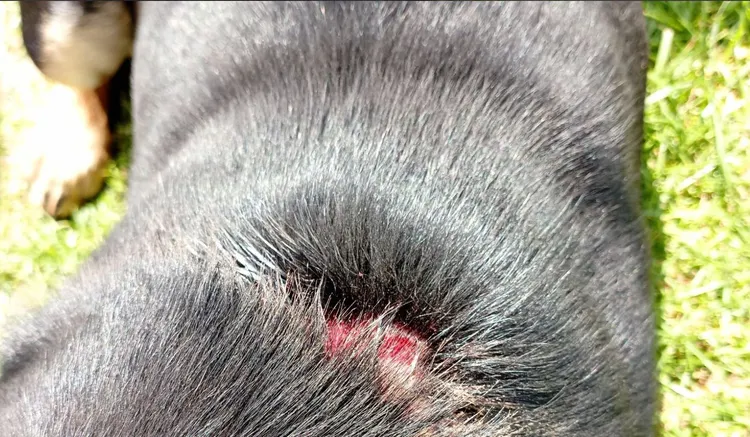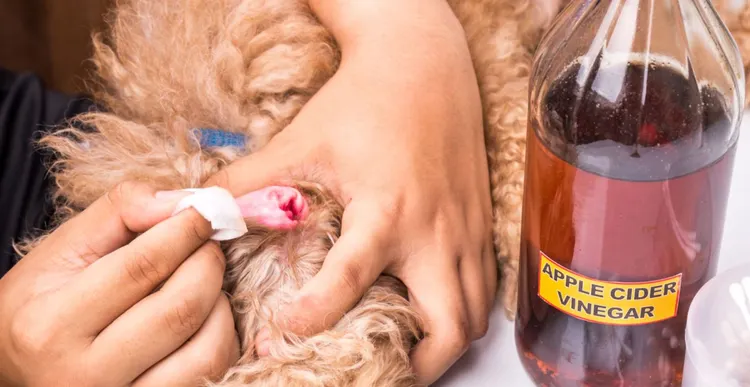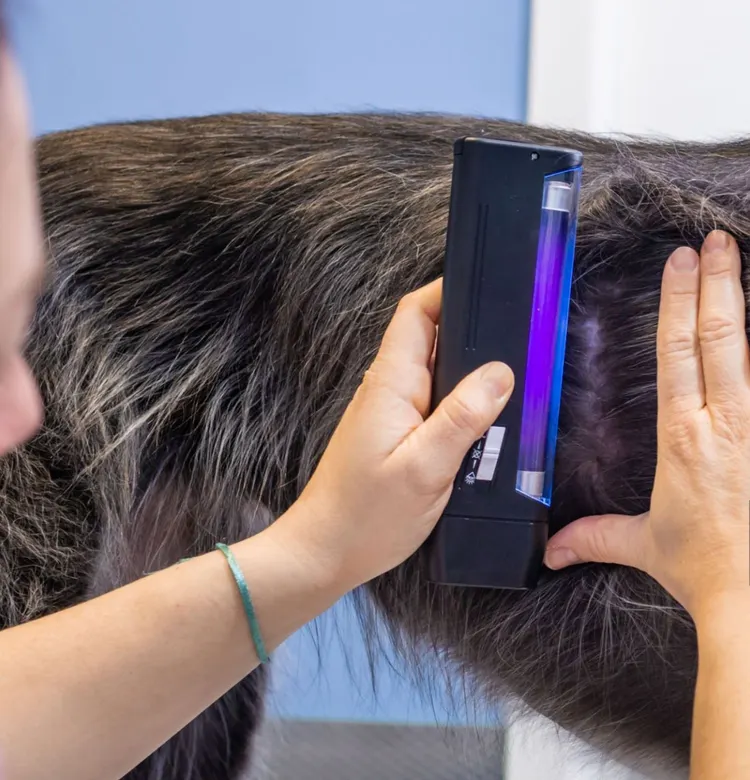Noticed a strange, patchy bald spot on your dog? It might not just be a harmless itch—ringworm could be the culprit! While its name might suggest a parasitic worm, ringworm is actually a fungal infection that affects the skin. The good news is, with early detection and proper care, ringworm is treatable. Even better, there are eco-friendly ways to handle the infection and prevent it from spreading. Let’s explore how to identify ringworm on your dog and discover some eco-conscious solutions for keeping your furry friend healthy.
What Does Ringworm Look Like on a Dog?
Identifying ringworm early is essential for effective treatment and to prevent the infection from spreading to other pets or family members. Here’s what you should look for:
Circular Bald Spots: A Common Indicator of Ringworm
One of the most recognizable signs of ringworm in dogs is the development of circular bald patches. The hair in the affected area often falls out, leaving behind a round, hairless lesion. These lesions may vary in size but are typically small and concentrated.
While these bald spots may look alarming, they are the body’s response to the fungal infection. The fungus feeds on the keratin in the dog’s skin and hair, causing localized hair loss.
Red or Inflamed Skin: Irritation Around the Lesions
The skin in the affected areas can appear red and inflamed. This redness is often accompanied by swelling, particularly in more severe cases. It’s important to note that while these red patches can be a strong indicator of ringworm, they may not always be present, especially in mild cases.
In some cases, the inflamed skin might cause your dog to scratch the area, which can worsen the infection if left untreated. Keep an eye on areas your dog seems to scratch excessively.
Scaly or Crusty Patches: Buildup of Dead Skin
Another telltale sign of ringworm is the formation of scaly or crusty patches on the skin. The fungus damages the skin, causing it to dry out and flake. This can lead to a buildup of dead skin cells around the lesions, giving the infection a rough, scaly appearance.
These crusty patches may also be accompanied by small bumps or pustules, especially if your dog has been scratching or if the infection is severe.
Common Locations: Head, Ears, Paws, and Legs
Ringworm can appear anywhere on a dog’s body, but it is most commonly found on the head, ears, paws, and legs. These areas are more likely to come into contact with contaminated surfaces or other infected animals.
Dogs who frequently dig, play outside, or interact with other animals may be more prone to developing ringworm in these areas, particularly if they have frequent contact with soil, which can harbor fungal spores.
How to Differentiate Ringworm from Other Skin Conditions
Many skin conditions in dogs share similar symptoms, so it’s important to distinguish ringworm from other issues to ensure the right treatment is used. Here’s how ringworm compares to other common skin conditions:

Ringworm vs. Hot Spots
Hot spots, also known as acute moist dermatitis, can be mistaken for ringworm due to the hair loss and irritation they cause. However, hot spots are usually moist, inflamed, and oozing, while ringworm lesions are typically dry and circular. Hot spots are often caused by excessive licking or scratching, while ringworm is a fungal infection that presents with scaly patches.
Ringworm vs. Mange
Mange, another skin condition caused by mites, also leads to hair loss and redness. However, mange typically causes widespread itching and irritation, while ringworm presents with more isolated circular lesions. Mange may also result in thickened, crusty skin across a larger area of the dog’s body, unlike the distinct spots found with ringworm.
Ringworm vs. Flea Allergies
Flea allergies often cause itching, redness, and hair loss, but these symptoms are typically more generalized and don’t form the characteristic circular lesions of ringworm. With flea allergies, you’ll likely see irritation on your dog’s back or the base of their tail, rather than the head and legs.
How Ringworm Spreads in Dogs
Ringworm is highly contagious and can spread between animals and humans. It’s caused by fungal spores that can survive on surfaces like bedding, toys, and grooming tools for months. Dogs can contract ringworm by direct contact with an infected animal or by touching contaminated objects or environments.
Because ringworm can spread so easily, early detection is critical. Once you suspect your dog has ringworm, it’s essential to isolate them from other pets and family members to prevent the infection from spreading.
Eco-Friendly Treatment Options for Ringworm
Treating ringworm doesn’t have to involve harsh chemicals or synthetic medications. There are several eco-friendly remedies and approaches that can help manage and clear up the infection.

Natural Antifungal Remedies
- Coconut Oil: Coconut oil has natural antifungal properties and can be applied topically to the affected area. Simply rub a small amount of virgin coconut oil onto the lesions daily to help soothe the skin and fight the infection.
- Apple Cider Vinegar: Apple cider vinegar is another natural remedy known for its antifungal properties. Dilute it with water and apply it to the affected areas with a cotton ball. This can help dry out the lesions and prevent further spread of the fungus.
Eco-Friendly Shampoos
Using natural, eco-friendly antifungal shampoos can help speed up recovery. Look for shampoos with ingredients like:
- Tea Tree Oil: Known for its antifungal and antiseptic properties, tea tree oil can be effective in treating mild ringworm infections.
- Chlorhexidine: This natural compound has antifungal and antibacterial properties and is safe for use on dogs. It’s commonly found in veterinary-grade eco-friendly shampoos.
When using antifungal shampoos, be sure to bathe your dog regularly, but avoid over-washing, as excessive bathing can dry out their skin.
Wash Bedding and Toys Naturally
To prevent reinfection, it’s essential to keep your dog’s environment clean. Wash their bedding, toys, and any other items they come into contact with using non-toxic, eco-friendly detergents. These products are not only safe for your dog and the environment but are also effective in killing fungal spores.
Disinfect with Natural Cleaners
Instead of relying on harsh chemicals to disinfect surfaces, opt for natural cleaning solutions. Vinegar and baking soda can be used to clean and sanitize areas where your dog spends time. These natural cleaners are effective in killing fungal spores while being safe for your family and the planet.
Prevention Tips: Keep Ringworm at Bay
Preventing ringworm in dogs involves regular grooming and maintaining a clean environment. Here are some eco-conscious tips to help reduce the risk of infection:
Maintain Cleanliness
Regular grooming is one of the best ways to spot infections early. Brush your dog’s coat frequently to remove dirt and debris, and check for signs of irritation or bald spots. Keeping your dog’s coat clean and healthy can help prevent fungal infections like ringworm.
Limit Exposure
Avoid letting your dog interact with other animals that show signs of infection, and steer clear of environments that could harbor fungal spores, such as unkempt parks or animal shelters. If you notice symptoms of ringworm in other dogs, keep your pet away to avoid the risk of transmission.
Use Eco-Friendly Disinfectants
To keep your home ringworm-free, use eco-friendly disinfectants made from natural ingredients like essential oils and vinegar. Regularly clean your dog’s living areas and items like collars, leashes, and toys to prevent reinfection.
Conclusion
Ringworm may look intimidating, but with early detection, the right treatment, and eco-friendly practices, your dog can bounce back quickly. From recognizing circular bald spots to using natural remedies like coconut oil and tea tree shampoo, managing ringworm in a sustainable way is possible. By keeping your pet’s environment clean and choosing non-toxic products, you’ll not only protect your dog but also contribute to a healthier planet. With these eco-conscious approaches, you can ensure that your dog stays healthy and happy while reducing your environmental footprint.



